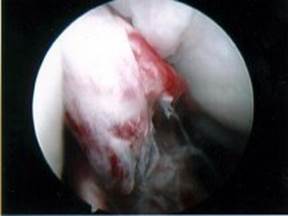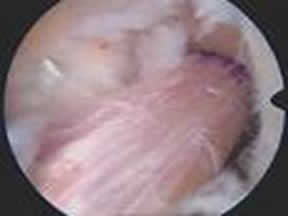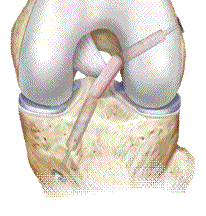Anterior Cruciate Ligament (ACL) Reconstruction
The anterior cruciate ligament is the main internal stabiliser of the knee. It is often injured in cutting or turning sports such as football and rugby.
Once ruptured, the ACL has no potential to heal. If you want to return to sport which involves changing direction quickly – then you probably require and ACL reconstruction. Occasionally only 1 out of the 2 bundles has torn – in this case I can reconstruct the torn part, leaving the original bundle intact.
Techniques in ACL reconstruction have rapidly advanced in recent years. I can offer the very latest “AM portal” technique which ensures anatomic placement of your graft. The older technique, which placed the graft via the “trans-tibial “approach, is now known not to restore rotational stability which could lead to rupture of the graft.
The aim of surgery is to restore knee stability without compromising movement. This will ensure rapid return to back to sport within 6-9 months.
Symptoms
Instability or giving way (especially changing direction or turning) Pain (if other structures have been damaged)
Before surgery
You will see a physiotherapist who will give you exercises that will ensure that the muscles (quadriceps and hamstrings) are in the best possible condition prior to surgery. You will practice with crutches and go through the stages for rehabilitation (link to ACL rehab) with them. You are usually required to attend a pre-operative assessment.
The operation
You will be admitted to the Charnwood Suite on the day of surgery. You will usually have a general anaesthetic. The procedure is mainly done through key-hole surgery. It is usual to have 4, 1cm incisions around the knee and 2-3cm incision on the inner aspect of your upper shin. The operation usually takes 60-90 minutes. I routinely use 2 of your own hamstring tendons from the inner thigh for the graft. The donor site is not usually painful afterwards and there is no significant decrease in flexion strength of the knee. These are doubled over to form a very strong graft (stronger than your original ACL!). 2 tunnels are made in the lower femur and upper tibia to pass the graft through the knee. The graft is slid through the tunnels and fixed to the femoral side using an Endobutton TM. The knee is then moved with the graft under tension to ensure a full range of movement of the knee is possible and that the graft is as taut as possible. The graft is fixed in the tibial tunnel using the Bio-intrafix TM system.
Arthroscopic view of a normal ACL left knee |
Arthroscopic view on torn ACL left knee |
Arthroscopic view of the reconstructed ACL right knee |
Final position of graft right knee |
After Surgery
After the operation, you will wake up in the recovery ward with a bandage around your knee. It should feel numb at this stage as I routinely infiltrate the knee with local anaesthetic at the end of the operation. An ice pack is used to reduce pain and swelling. Once back on the ward, you will be encouraged to mobilise, partial weight-bearing (approx 20kg) with crutches for 2weeks. If the operation is done in the morning, you will usually be discharged home on the same day. If done in the afternoon or evening, then its likely that you will stay overnight.
Careful rehabilitation is crucial for the success of the procedure. This starts before the operation and lasts until you are able to return to sport. You will be guided through this phase by expert physiotherapists. If the rehabilitation is too aggressive after the operation or you return to sport too early the graft is at risk of stretching or rupturing. To find out more about rehabilitation click here.
ACL rehabilitation
There are 4 phases:
Phase 1 (Before the operation) Preparing muscles for surgery
Phase 2 (0-2 weeks) Early recovery
Phase 3 (2-6 weeks) Initial strengthening
Phase 4 (6 weeks -6 months) Functional recovery
Phase 1
To get the best result following ACL reconstruction – you must ensure that the quadriceps and hamstrings are at their strongest and that you have a full range of movement of the knee.
Suggested activities: rowing, cross trainer, swimming (free-style kick only) and cycling.
Phase 2
Reduce the swelling and pain by elevating the leg and placing a cold compress on the knee (tea-towel and frozen peas). You should be partially weight bearing with crutches. To find out how much weight you should be putting through the operated knee – step on a weighing scales to about 20kg. Moving the knee straight after the operation is very important to regain full range of motion.
Suggested activities: Range of motion exercises
Phase 3
You are now able to fully weight bear without crutches. Exercises will be “closed chain” ie the foot of the operated leg will be in contact with a surface (pedal of a bike).
By the end of this phase you should have regained full range of motion
Suggested activities: cycling, gentle cross-trainer
Phase 4
Under the guidance of your physiotherapist, there will be a gradual increase in the level of straight line activities such as fast walking and jogging. From about 3 months your physio will introduce more strenuous exercises like jumping, changing direction, running and rapid deceleration. At around 6 months, your muscle strength should have returned to normal. I will review you at that stage to see whether you can return to sport.
Suggested activities: swimming, cycling, jogging, gym-work
What are the risks?
Complications are rare after ACL surgery.
Stiffness – this can persist 6-8 weeks after the operation. It is important to adhere to your rehabilitation programme.
Infection – the chance of a wound infection is about 1 in 100 (1%). You will be given antibiotics during your operation to minimize this risk.
Blood clots (DVT/PE) – the best way to prevent this is to start walking as soon as possible after the operation. The oral contraceptive pill should be stopped 6 weeks prior to surgery.
Graft failure – this is strongly associated with over aggressive rehabilitation or returning to contact sports too early.
Further information
Please click here for more information.




